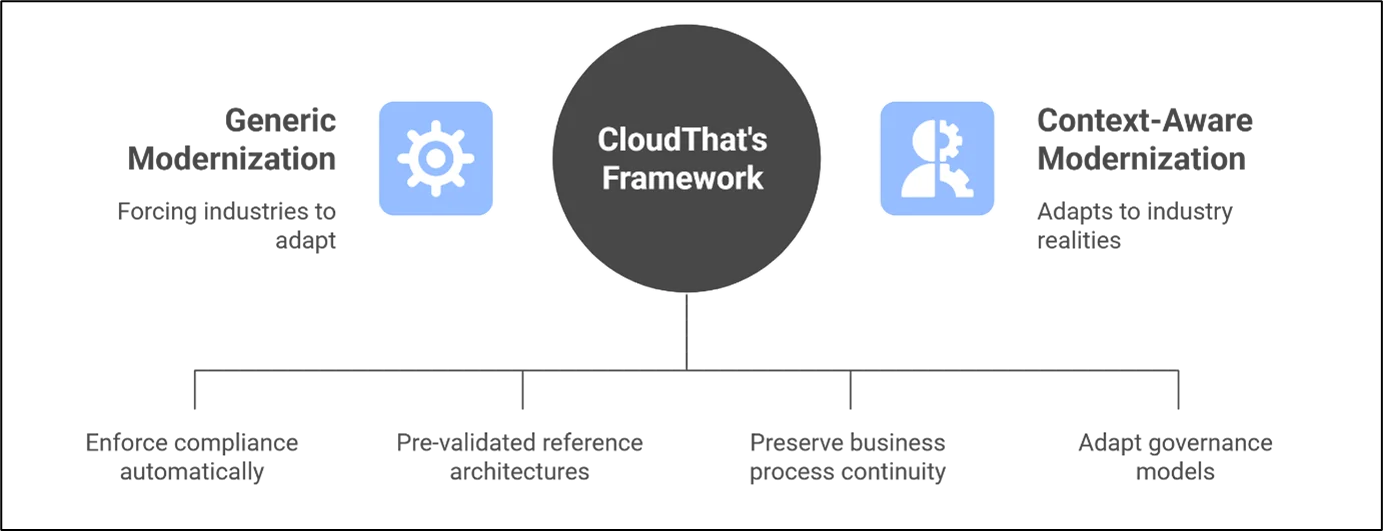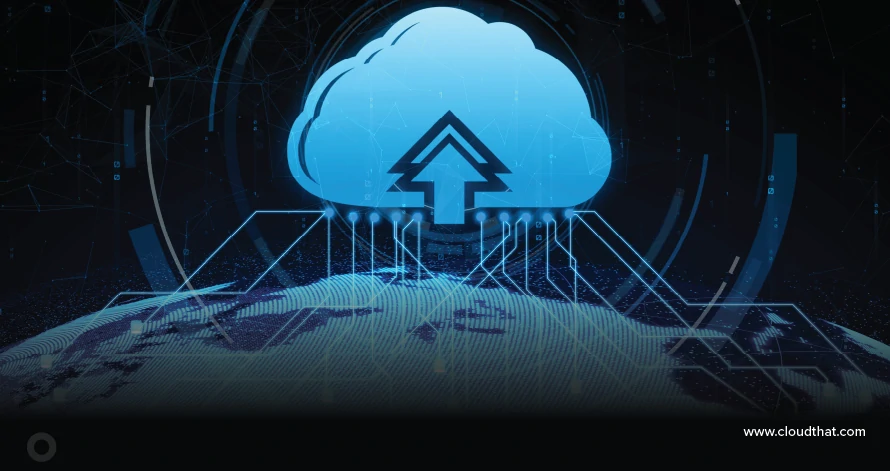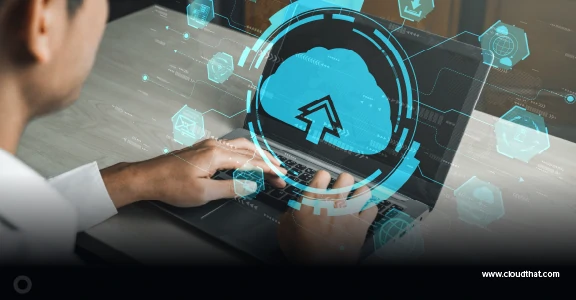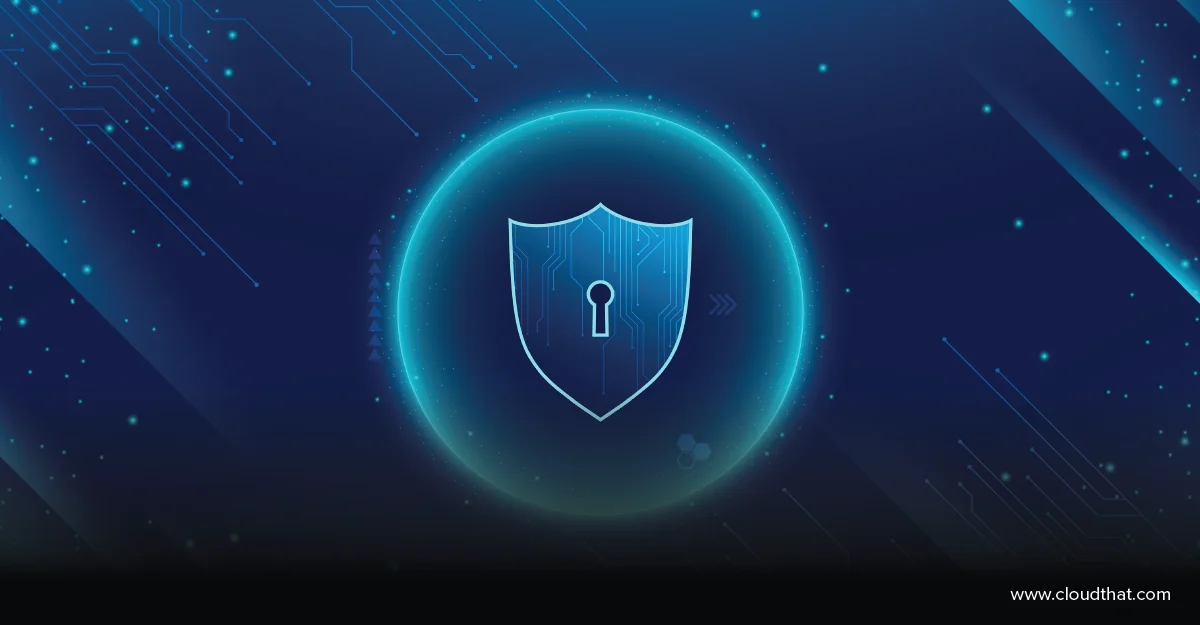|
Voiced by Amazon Polly |
When Generic Strategies Meet Real-World Complexity
Last quarter, a healthcare CTO reached out after a disastrous attempt at modernization. Their previous consultant had promised a “proven cloud migration framework”, the same one used for retail clients and SaaS startups. Six months and huge cost later, they faced HIPAA audit findings, clinical workflow disruptions, and EHR integration failures that threatened patient care continuity. The technology worked perfectly in sandbox environments. In production, with real patient data and regulatory oversight, it collapsed.
This story isn’t unique. The enterprise cloud modernization market is projected to reach $1.2 trillion by 2027. Yet, Gartner reports that through 2025, 70% of organizations embarking on cloud modernization without industry-specific frameworks will fail to achieve their business objectives. The difference between success and failure rarely lies in choosing the right technology stack, it lies in understanding that industry context, regulatory requirements, and business models fundamentally shape what successful transformation looks like.
In this article, we’ll examine why generic modernization approaches systematically fail, explore unique challenges across key industries, and present a framework for context-aware transformation refined through multiple modernizations achieving 99.9% uptime and 45% cost optimization.
Industry-Specific Challenges: Why Context Determines Architecture
BFSI: Where Milliseconds and Regulations Collide
Banking and financial services operate in the most complex regulatory environment in enterprise IT. Modernization here means maintaining compliance with PCI-DSS, SOC 2, and regional financial regulations while ensuring zero downtime during business hours.
Legacy mainframe systems running COBOL contain decades of business logic that processes millions of daily transactions with extremely high consistency requirements. Data residency requirements demand multi-region architectures with careful geographic partitioning. Real-time fraud detection requires response times of single digits of milliseconds while processing thousands of transactions per second.
Our approach: We implement the strangler fig pattern for gradual migration, allowing legacy and modern systems to coexist. Compliance-as-code frameworks ensure every deployment automatically validates against regulatory requirements. We design architectures that maintain ACID transaction guarantees where needed while leveraging eventual consistency for appropriate use cases.
Key insight: In BFSI, the migration path matters as much as the destination. You can’t have a “big bang” cutover when processing $500M in daily transactions.
Healthcare: Where Patient Safety Meets Innovation
Healthcare modernization operates under a unique constraint: clinical workflow continuity isn’t optional. When we modernize a hospital’s EHR integration layer, emergency room physicians must still be able to access patient records without disruption.
HIPAA compliance pervades every architectural decision. Protected Health Information (PHI) requires encryption at rest and in transit, as well as comprehensive audit logging and data handling procedures that extend to backup systems and development environments. A single misconfigured S3 bucket can result in multi-million dollar fines.
Integration challenges are acute in healthcare. A typical hospital operates dozens of interconnected systems, including EHR, PACS for medical imaging, laboratory systems, and pharmacy management, each with different data formats and protocols that can’t be modernized in isolation.
Our approach: We implement PHI-aware containerization, where sensitive data handling is integrated into the infrastructure. Encrypted data pipelines ensure compliance from source to destination. Zero-trust architecture principles mean every service interaction requires authentication. Most critically, we design migration paths that maintain parallel run capabilities until clinical validation confirms functional equivalence.
E-commerce: Elasticity Meets Extreme Variability
E-commerce presents extreme load variability challenges. A typical retail platform might handle 10,000 transactions per hour on a normal day, spiking to 500,000 during Black Friday, then dropping back to normal within hours. Generic approaches often optimize for steady-state performance, leaving organizations scrambling during peak events.
Payment processing introduces PCI-DSS compliance alongside real-time inventory management. Global operations necessitate sophisticated CDN strategies and multi-region deployments, striking a balance between consistency and performance.
Our approach: We architect for elasticity using auto-scaling patterns that respond to traffic in real-time. Serverless architectures handle spiky workloads cost-effectively. Event-driven patterns ensure loose coupling between services, allowing independent scaling of checkout, inventory, and fulfillment systems.
CloudThat's Context-Aware Modernization Framework
Through multiple transformations across diverse industries, we’ve developed the Context-Aware Modernization Framework, a methodology that adapts to industry realities rather than forcing industries to adapt to generic templates.
Four foundational pillars:
- Regulatory Intelligence Layer – Regulatory requirements built directly into infrastructure as code. For BFSI clients, PCI-DSS controls are automatically enforced. Healthcare deployments include HIPAA compliance validation in CI/CD pipelines.
- Domain-Specific Architecture Patterns – Pre-validated reference architectures for each vertical. Our BFSI patterns include mainframe integration and real-time fraud detection. Healthcare patterns incorporate PHI handling and clinical workflow orchestration.
- Industry Workflow Integration – We invest time understanding actual business operations before designing solutions, preserving business process continuity while enabling technical transformation.
- Sector-Specific Risk Management – Governance models adapt to varying risk tolerances, balancing innovation with appropriate risk controls.

As an AWS DevOps Competency Partner, we align these pillars with AWS’s industry-specific capabilities, leveraging services purpose-built for regulated industries, such as Amazon HealthLake for healthcare or AWS GovCloud for public sector workloads.
Selecting an Industry-Aware Modernization Partner
Look for domain expertise indicators:
- Reference to specific regulatory frameworks without prompting
- Detailed discussion of industry-specific challenges beyond generic “compliance”
- Case studies demonstrating outcomes that matter in your industry
Red flags:
- Uniform timelines are proposed before understanding your regulatory environment
- Focus on technology choices before discussing business processes
- Case studies from wildly different industries presented as relevant proof
AWS competencies signal validated expertise, but equally important is whether partners hold industry-specific certifications and maintain teams with deep vertical knowledge.
The Bottom Line: Context Is Strategy
Cloud modernization success isn’t determined by choosing the right cloud provider or implementing the latest architectural patterns, it’s determined by understanding that modernization is business transformation enabled by technology, not technology implementation that hopefully benefits the business.
Industry context fundamentally shapes successful modernization. A generic approach might deliver functional technology systems, but fail to deliver business value. An industry-specific approach recognizes that successful banking transformation looks nothing like successful healthcare transformation, even when both run on identical infrastructure.
Is your current modernization strategy truly industry-aware, or are you implementing someone else’s solution to someone else’s problems?
Drop a query if you have any questions regarding Cloud modernization and we will get back to you quickly.
Empowering organizations to become ‘data driven’ enterprises with our Cloud experts.
- Reduced infrastructure costs
- Timely data-driven decisions
About CloudThat
CloudThat is an award-winning company and the first in India to offer cloud training and consulting services worldwide. As a Microsoft Solutions Partner, AWS Advanced Tier Training Partner, and Google Cloud Platform Partner, CloudThat has empowered over 850,000 professionals through 600+ cloud certifications winning global recognition for its training excellence including 20 MCT Trainers in Microsoft’s Global Top 100 and an impressive 12 awards in the last 8 years. CloudThat specializes in Cloud Migration, Data Platforms, DevOps, IoT, and cutting-edge technologies like Gen AI & AI/ML. It has delivered over 500 consulting projects for 250+ organizations in 30+ countries as it continues to empower professionals and enterprises to thrive in the digital-first world.
FAQs
1. Why do 70% of cloud modernization projects fail to achieve their business objectives?
ANS: – Generic modernization approaches ignore industry-specific regulatory requirements, business processes, and operational constraints. They prioritize architectural elegance over business continuity and apply uniform timelines that don’t account for regulatory approval cycles. For example, a healthcare system can’t use the same migration strategy as an e-commerce platform because HIPAA compliance, clinical workflow continuity, and PHI handling requirements fundamentally change the architecture and migration approach.
2. What makes healthcare and banking modernization different from other industries?
ANS: – Healthcare requires clinical workflow continuity (emergency room physicians must access patient records without disruption), HIPAA compliance for all PHI handling, and integration with dozens of interconnected systems like EHR and PACS. Banking operates under complex regulatory frameworks (PCI-DSS, SOC 2), processes millions of daily transactions requiring ACID guarantees, and needs real-time fraud detection with millisecond response times. Generic approaches that work for retail collapse when they meet these industry-specific constraints.
3. How can we identify if a modernization partner truly understands our industry?
ANS: – Look for partners who reference specific regulatory frameworks without prompting, discuss industry-specific challenges beyond generic “compliance,” and present case studies with outcomes that matter in your vertical. Red flags include proposing uniform timelines before understanding your regulatory environment, focusing on technology choices before business processes, and presenting case studies from unrelated industries as relevant proof. Industry-specific certifications and teams with deep vertical knowledge are essential indicators.

WRITTEN BY Saurabh Jain
Saurabh Kumar Jain is the CSA – Projects Head for DevOps and Kubernetes at CloudThat. An innovative Solutions Architect and technical leader, he is passionate about driving digital transformation across diverse industries. He specializes in designing enterprise-grade, cloud-native solutions, with deep expertise in multi-cloud platforms, Kubernetes orchestration, and AI-powered automation. Saurabh has extensive experience in architecting secure, scalable systems for sectors including oil & petroleum, financial services, e-commerce, and government organizations. He is recognized for his thought leadership in modernization strategies, GitOps workflows, and comprehensive observability implementations. In his free time, he explores emerging technologies in AI and GenAI, contributes to open-source projects, and shares knowledge through technical content and industry speaking engagements.


 Login
Login


 November 12, 2025
November 12, 2025 PREV
PREV










Comments